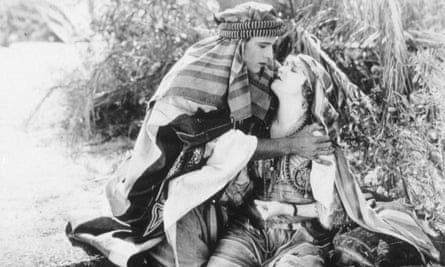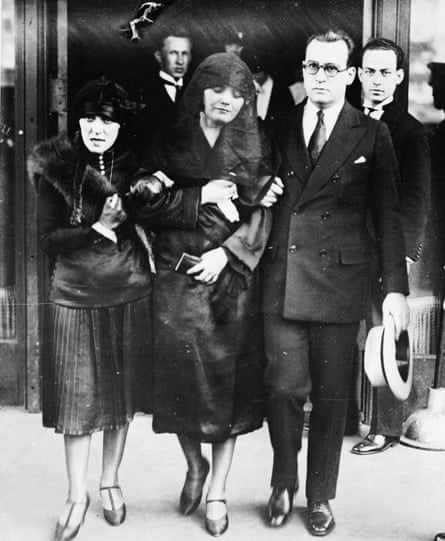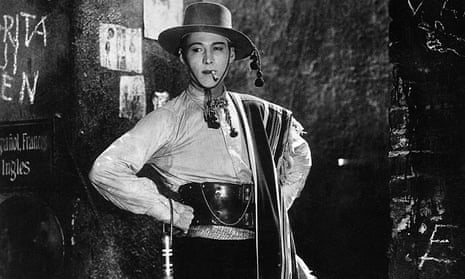Rodolfo Guglielmi was born in 1895 in a farmhouse in Castellaneta, southern Italy. He died 31 years later in New York City, a heart-throb known to millions as Rudolph Valentino. The combination of beauty and an early death can transform any star into a legend. But Valentino was more than just a star to begin with. In his adopted homeland of America, he was an object of both devotion and open hatred. Thousands of young women turned out to mourn Valentino at his funeral and some reportedly killed themselves in despair when they heard the news. But while America’s daughters were sobbing, many American men were delighted to see the back of him.
Ken Russell’s lurid, but gorgeously art-directed quasi-biopic Valentino (1977), which is released on Blu-ray this week, is not the place to turn for the facts about the actor’s life. “I can be as inaccurate as I want to,” said Russell. “My films are novels, based on a person’s life, and a novel has a point of view. I’m not interested in making documentaries.” Nor is its nimble star Rudolf Nureyev a physical match for doughy, dark-haired Valentino. But in its hyperactive, highly strung portrayal of Valentino as a chaste sex symbol, it gets to the heart of why he continues to be an object of morbid fascination and sexual speculation.
The Guardian’s report of Valentino’s death in 1926 surmised primly that: “He was to American flappers generally almost what the Prince of Wales is to the English.” With the benefit of hindsight, that is hilarious. The beginning and end of Valentino’s appeal was sex. Dancing a steamy tango in The Four Horsemen of the Apocalypse (1921) or commanding his lover to “Lie still, you little fool!” in both The Sheik (1921) and The Son of the Sheik (1926), Valentino performed a violently sexual passion on screen. Fan magazines praised the “red-hot” romance of his pictures, and women found him irresistible. But elsewhere in the press, male writers sharpened their pens.
Jealousy can almost always be taken as a compliment. “I hate Valentino!” joked “slang reviewer” Dick Dorgan in Photoplay. “All men hate Valentino … he has been the cause of more home-cooked battle royals than they can print in the papers. The women are all dizzy over him. The men have formed a secret order (of which I am running for president and chief executive as you may notice) to loathe, hate and despise him for obvious reasons.”
To a certain extent, this is all very flattering, and every time Valentino’s films were called homewreckers, women were all the more keen to see them. But other writers were more serious, and chose to undermine the image of the screen’s Great Lover with allusions to his supposed effeminacy. Movie acting was not considered to be a macho career, but worse, Valentino was a dancer as well. When he first arrived in the US in 1913, he had worked as a “taxi dancer”, a profession synonymous in many people’s minds with being a gigolo. There had been a scandal back then, too, a messy one involving a divorce case and a murder that resulted in Valentino being arrested in a raid on a brothel.

Valentino always told reporters he wanted a partner who would be the perfect Italian-style housewife and mother (“a man should pick out a woman who is pretty, has a good disposition, and is domestically inclined”), but his marital misadventures tell a different story. He was married twice, first to actor Jean Acker – although they never consummated the marriage, as Valentino chose his wedding day to tell her that he had gonorrhoea. His second wife was flamboyant art director and costume designer Natacha Rambova. They were forced to separate when they were still newlyweds, as Valentino was still legally married to Acker. Rambova fled to New York, while Valentino was sent to jail, to be prosecuted for bigamy. In Russell’s film, this is escalated to a grotesque vomit and urine-splashed vignette, with Rambova and Valentino in adjoining cells on their wedding night.
The prison officer who taunts Valentino in that gruesome scene voices many of the attacks that hounded him. From his time on the New York dancefloors to his Hollywood heyday, many writers took issue with the way that Valentino dressed. At first they remarked on the fact that he wore a corset (Valentino had to reconcile his love of spaghetti with his trim tuxedos somehow) and they even took exception to his watch. The fashionable Valentino wore a wristwatch, a relatively new invention, which was considered far too much like a bracelet by macho types who preferred the pocket variety. And speaking of bracelets, when Rambova bought him a “slave bracelet”, the press scented blood. A man wearing jewellery, jewellery that connotes ownership, bought for him by a woman! Valentino loved that bracelet and defiantly wore it every day, as part of an outlandishly expensive wardrobe that included jewelled rings, fur coats and silk cravats.

From the suggestion of sex work to the whiff of feminine style, many of these barbs were simply stabs at saying Valentino was gay. It is a rumour that persists, and it pervades Russell’s film completely, which is based loosely on a biography that asserts Valentino’s homosexuality. There is some evidence, much of it disputed or from unreliable sources such as Kenneth Anger’s Hollywood Babylon, to suggest that Valentino had sexual relationships with men. And similarly, anecdotal evidence from his girlfriends and female co-stars suggests that he was not so interested in sex, with them at least. But then he was married twice, and engaged (to Pola Negri) when he died. Understandably, because it might not have been true and because it was the 1920s, Valentino went to great lengths to deny accusations that hinted at homosexuality. One of the strangest episodes in Valentino’s life was the time he took up boxing in order to prove his virility. In Russell’s film, this is what leads to Valentino’s death, rather than the more prosaic truth (peritonitis).
It began with an editorial in the Chicago Tribune, a spiteful piece of writing that manages to be both racist and homophobic. The writer declares himself outraged to find a face-powder dispenser in a men’s bathroom, and places the blame on a movie star. Valentino had turned America’s women on to sex, and now, allegedly, he had turned America’s men on to male grooming. “Homo Americanus! Why didn’t someone quietly drown Rudolph Guglielmo, alias Valentino, years ago? … Hollywood is a national school of masculinity. Rudy, the beautiful gardener’s boy, is the prototype of the American male. Hell’s bells. Oh, sugar.”
Valentino responded with an angry letter to a rival paper “You cast doubt upon my manhood … I defy you to meet me in the boxing … arena.” He saw the “pink powder puff” attack as racist in its motivation, because he was a foreigner working in the US. When the writer, who it turned out was sick with TB, failed to respond, Valentino flexed his muscles by decking a couple of stooges in exhibition matches in New York and Chicago instead. Ken Russell’s version of events is naturally far more dramatic, with Nureyev squaring up to a beefy hack played by Peter Vaughan and tackling a drinking contest as a sequel to the bout.
Valentino was far more talented as a dancer than as an actor, but even the best of his screen performances can’t compete with the legend. He will be remembered as much for what was said about him as what he did. The gossip is often prurient, but Valentino deserves to be remembered as a man who provoked great passion – and inspired some extraordinary storytelling.

Comments (…)
Sign in or create your Guardian account to join the discussion